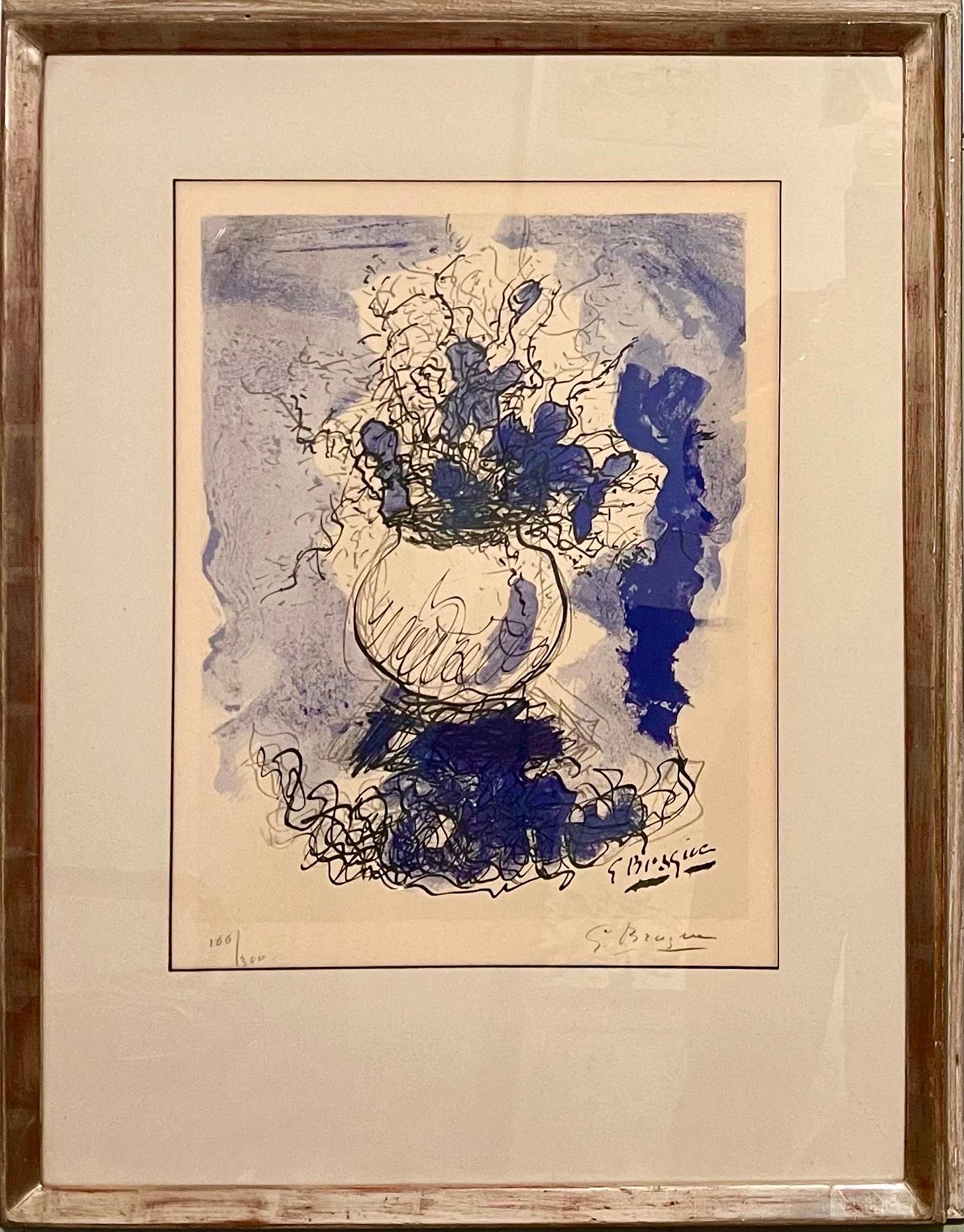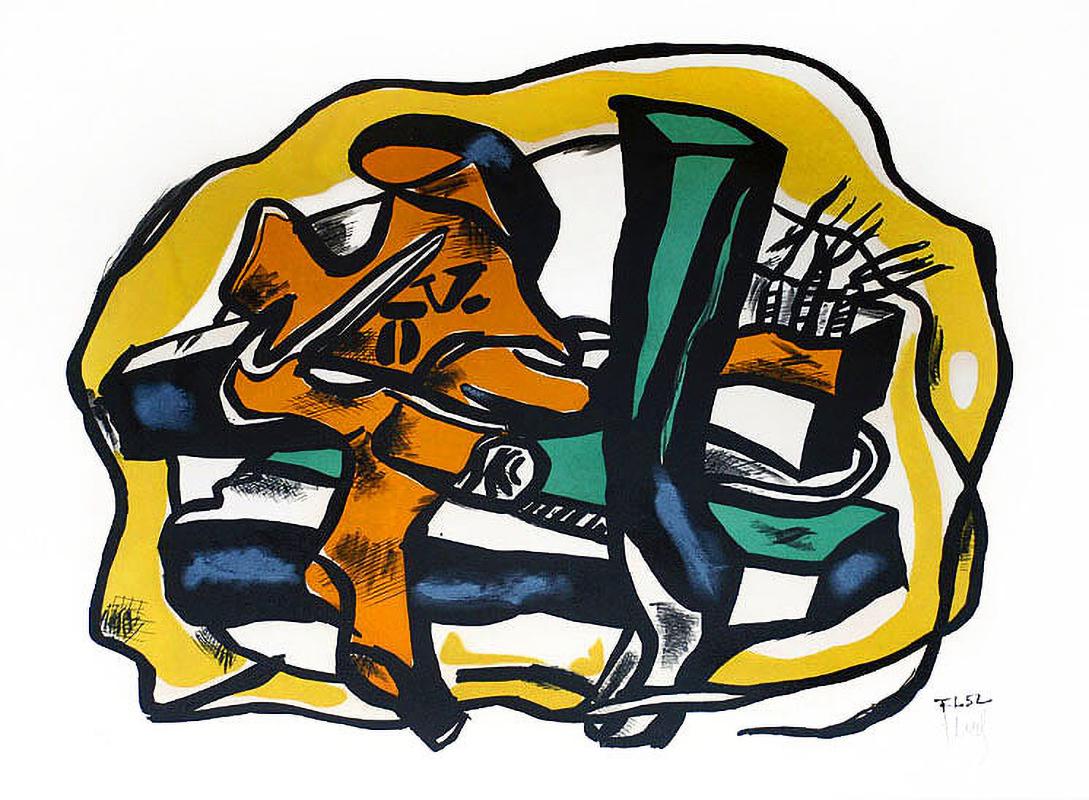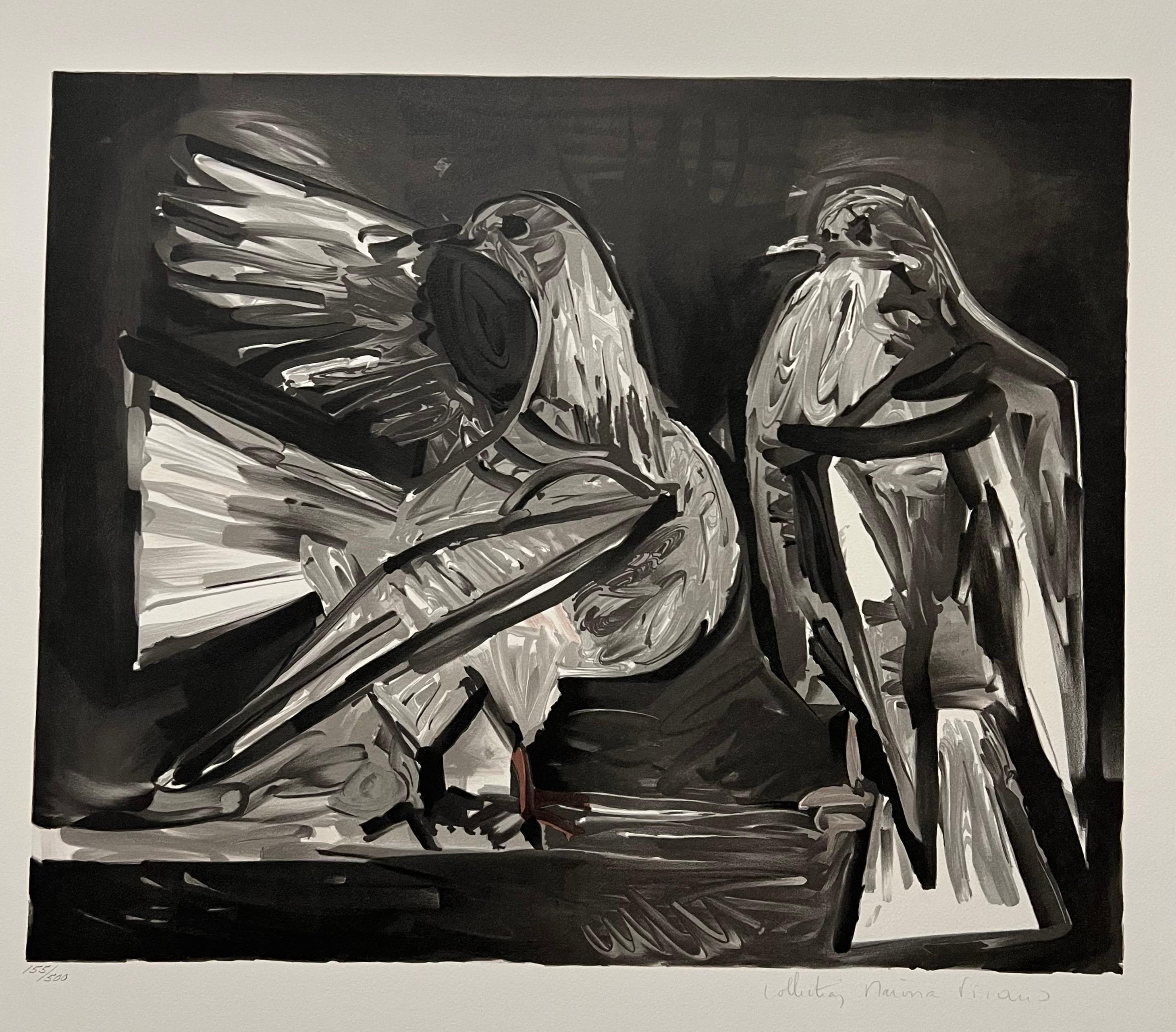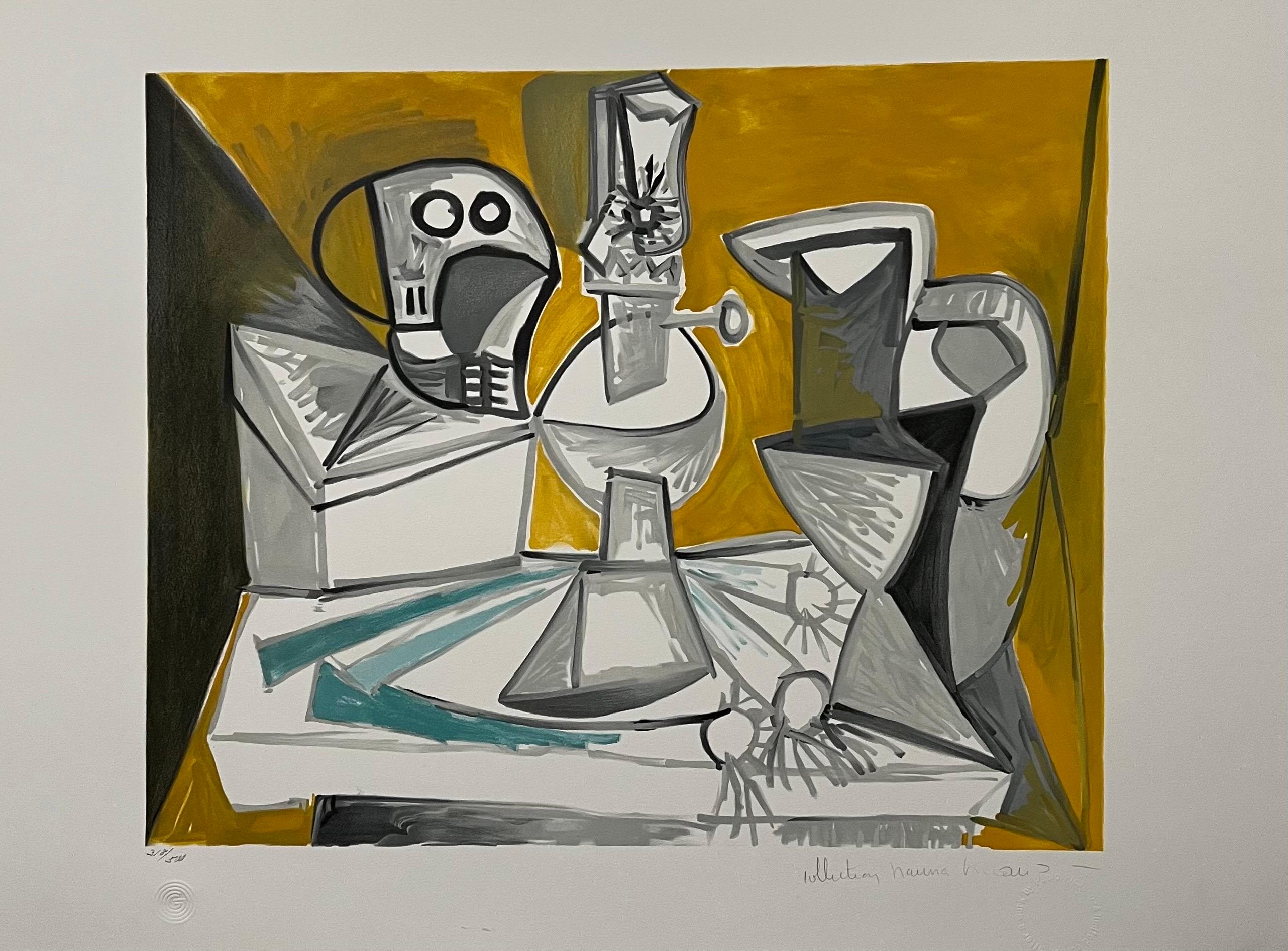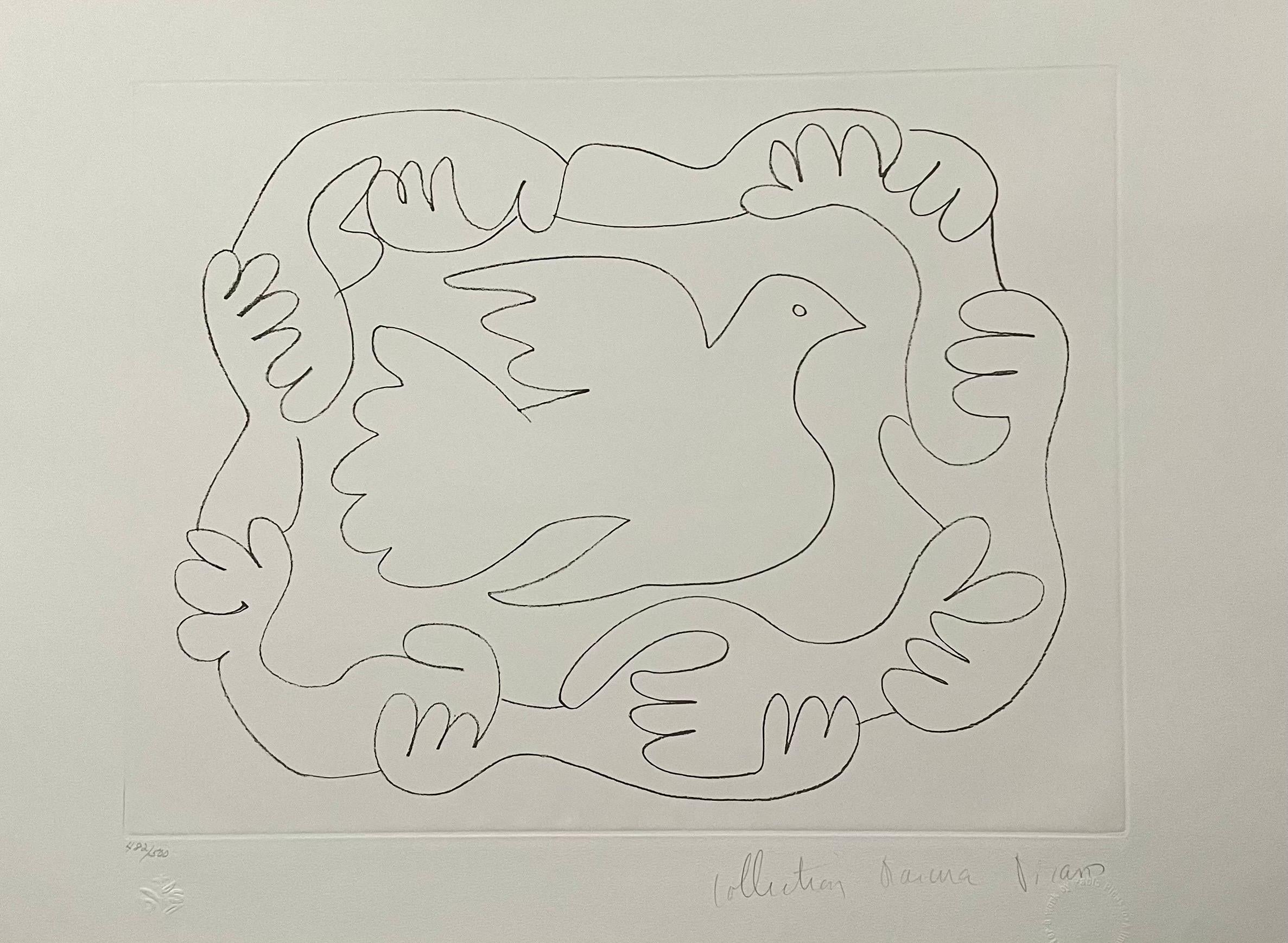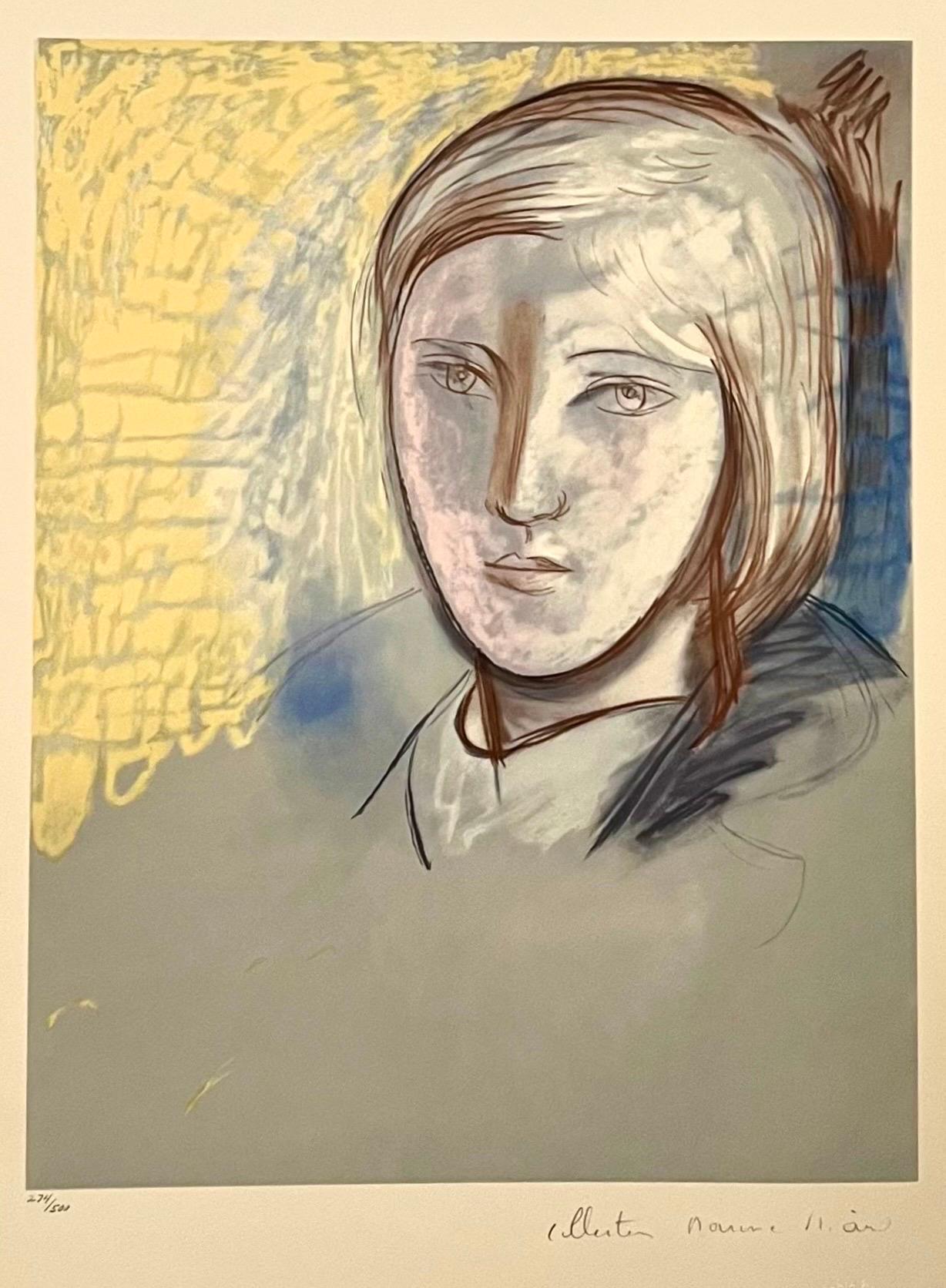Items Similar to Léger, Composition, Derrière le miroir (after)
Want more images or videos?
Request additional images or videos from the seller
1 of 9
Léger, Composition, Derrière le miroir (after)1949
1949
About the Item
Lithograph on wove paper. Inscription: Unsigned and unnumbered, as issued. Good Condition; with centerfold, as issued. Notes: From Derrière le miroir, N° 20-21, published by Derrière le miroir, Paris; printed by Galerie Maeght, Paris, 1949. Notes: Excerpted from a Christie’s, New York lot essay, The life span of Derrière le Miroir was thirty-five years. Publication began in 1946. Aimé Maeght, initiator of Derrière le Miroir, had already made few attempts to start publications illustrated with fine printed lithographs in colours in the years prior to the launch of Derrière le Miroir. The name, Derrière le Miroir was suggested by Jacques Kober, manager of Galerie Maeght. The gallery had opened in 1945; the first number of Derrière le Miroir was released a year later. For this first issue Geer van Velde was invited to create lithographs to illustrate the publication. The lithographs in the first issue was printed by Mourlot, Paris. The first three issues of Derrière le Miroir were unsuccessful for Maeght as far as the edition size—the initial print-runs were far too large. From 30,000 for the first issue, the number was taken down to 10,000 for numbers two and three, until Derrière le Miroir number four was published in an edition of 1500. Maeght instituted a policy whereby unsold issues were recycled and used for the fabrication of new paper for the coming editions—this served to both conserve resources and also usually result in ultimate edition sizes far less than 1,500. With number four, the permanent format for Derrière le Miroir was established. Lithographs in colours were key; text was limited to comments on the featuring artist's exhibition taking place in the Galerie Maeght, and this catalogue format was defining to Derrière le Miroir. Galerie Maeght took on the leading role in Paris and presented all main artists including Braque, Matisse, Chagall, Léger, Bonnard, Chillida and many more. So too did Derrière le Miroir. The idea of a magazine was meanwhile still on the mind of Aimé Maeght. He found an insert as a solution. Two, and later four, pages of art review were inserted from 1952 onwards. In 1968 this find had ripened to independency and the dream of Aimé Maeght was now a tangible fact named l'Art vivant. Derrière le Miroir was on it's own again. Over 250 issues in a row. At that point publisher Aimé Maeght wished to make a mark with the publication of an hommage to all who once contributed to the magazine which came in the form of issue number 250, but was delayed by the death of Aimé Maeght. It was published after number 253 in 1982 and became a tribute to Aimé and Marguérite Maeght and 35 years of friendship with artists and poets. The era of Derrière le Miroir was closed with that final publication.
FERNAND LEGER (1881-1955) was a French painter, sculptor, and filmmaker. In his early works he created a personal form of cubism (known as "tubism") which he gradually modified into a more figurative, populist style. His boldly simplified treatment of modern subject matter has caused him to be regarded as a forerunner of pop art. Léger was born in Argentan, Orne, Lower Normandy, where his father raised cattle. Fernand Léger initially trained as an architect from 1897 to 1899, before moving in 1900 to Paris, where he supported himself as an architectural draftsman. After military service in Versailles, Yvelines, in 1902–1903, he enrolled at the School of Decorative Arts after his application to the École des Beaux-Arts was rejected. He nevertheless attended the Beaux-Arts as a non-enrolled student, spending what he described as "three empty and useless years" studying with Gérôme and others, while also studying at the Académie Julian. He began to work seriously as a painter only at the age of 25. At this point his work showed the influence of impressionism, as seen in Le Jardin de ma mère (My Mother's Garden) of 1905, one of the few paintings from this period that he did not later destroy. A new emphasis on drawing and geometry appeared in Léger's work after he saw the Cézanne retrospective at the Salon d'Automne in 1907. In 1909, he moved to Montparnasse and met Alexander Archipenko, Jacques Lipchitz, Marc Chagall, Joseph Csaky and Robert Delaunay. In 1910, he exhibited at the Salon d'Automne in the same room (salle VIII) as Jean Metzinger and Henri Le Fauconnier. In his major painting of this period, Nudes in the Forest, Léger displays a personal form of Cubism that his critics termed "Tubism" for its emphasis on cylindrical forms. In 1911, the hanging committee of the Salon des Indépendants placed together the painters identified as 'Cubists'. Metzinger, Albert Gleizes, Le Fauconnier, Delaunay and Léger were responsible for revealing Cubism to the general public for the first time as an organized group. The following year he again exhibited at the Salon d'Automne and Indépendants with the Cubists, and joined with several artists, including Le Fauconnier, Metzinger, Gleizes, Francis Picabia and the Duchamp brothers, Jacques Villon, Raymond Duchamp-Villon and Marcel Duchamp to form the Puteaux Group—also called the Section d'Or (The Golden Section) paintings, from then until 1914, became increasingly abstract. Their tubular, conical, and cubed forms are laconically rendered in rough patches of primary colors plus green, black and white, as seen in the series of paintings with the title Contrasting Forms. Léger made no use of the collage technique pioneered by Braque and Picasso.
- Creation Year:1949
- Dimensions:Height: 15 in (38.1 cm)Width: 22 in (55.88 cm)
- Medium:
- Movement & Style:
- After:Fernand Léger (1881-1955, French)
- Period:
- Condition:
- Gallery Location:Auburn Hills, MI
- Reference Number:1stDibs: LU1465214004382
About the Seller
4.9
Gold Seller
These expertly vetted sellers are highly rated and consistently exceed customer expectations.
Established in 2002
1stDibs seller since 2021
871 sales on 1stDibs
Typical response time: 1 hour
- ShippingRetrieving quote...Ships From: Clinton Township, MI
- Return PolicyA return for this item may be initiated within 1 day of delivery.
More From This SellerView All
- Moore, Red and Blue Standing Figures (Cramer 36), XXe Siècle (after)By Henry MooreLocated in Auburn Hills, MILithograph on wove paper. Inscription: Unsigned and unnumbered, as issued. Good Condition; never framed or matted. Notes: From the volume, XXe Siècle, n°1, 1951. Published by Edition...Category
1950s Modern Figurative Prints
MaterialsLithograph
- Léger, Nature morte aux clefs, Derrière le miroir (after)By Fernand LégerLocated in Auburn Hills, MILithograph on wove paper. Inscription: Signed in the plate and unnumbered; text on verso, as issued. Good Condition; with centerfold, as issued. Notes: From Derrière le miroir, N° 79...Category
1950s Modern Abstract Prints
MaterialsLithograph
- Miró, Solar Bird, Lunar Bird, Sparks (Mourlot, 567), XXe Siècle (after)By Joan MiróLocated in Auburn Hills, MILithograph on wove paper. Unsigned and unnumbered, as issued. Good Condition with quadfold, as issued; never framed or matted. Notes: From the volume, XXe Siècle, vol. no. 28, 1967. ...Category
1960s Modern Figurative Prints
MaterialsLithograph
- Léger, Femme et enfant, Derrière le miroir (after)By Fernand LégerLocated in Auburn Hills, MILithograph on wove paper. Inscription: Signed in the plate and unnumbered; text on verso, as issued. Good Condition. Notes: From Derrière le miroir, N° 79-80-81, published by Derrièr...Category
1950s Modern Abstract Prints
MaterialsLithograph
- Soulages, Composition, XXe Siècle (after)By Pierre SoulagesLocated in Auburn Hills, MILithograph on wove paper. Unsigned and unnumbered, as issued. Good Condition; never framed or matted. Notes: From the volume, XXe Siècle, vol. no. 34, 1970. Published by Editions XXe...Category
1970s Modern Figurative Prints
MaterialsLithograph
- Léger, Nature morte, Derrière le miroir (after)By Fernand LégerLocated in Auburn Hills, MILithograph on wove paper. Inscription: Signed in the plate and unnumbered; text on verso, as issued. Good Condition. Notes: From Derrière le miroir, N° 79-80-81, published by Derrièr...Category
1950s Modern Abstract Prints
MaterialsLithograph
You May Also Like
- Georges Braque Bouquet de Fleurs Lithograph Bold Blue Hand Signed Ltd Ed PrintBy Georges BraqueLocated in Surfside, FLGeorges Braque (French, 1882-1963) Bouquet de Fleurs Lithograph in colors, 1957. Published by Maeght, printed by Mourlot, Paris, France Numbered 166/300 and hand signed in pencil. ...Category
20th Century Modern Figurative Prints
MaterialsLithograph
- Composition sur fond jauneBy Fernand LégerLocated in Palo Alto, CAutting a new spin on one of his favorite subjects, Léger here depicts tree trunks and logs as objects in space rather than related to the ground. The gnarled branches form an abstract still-life composition, twisting and turning in unanticipated directions. The earthy browns, greens, and yellows contrast with the bold black outlines. The logs appear as though arranged on a platter, presented to the viewer for contemplation. An intriguing aspect of this piece is the tiny box...Category
1950s Modern Abstract Prints
MaterialsLithograph
- Pablo Picasso Estate Hand Signed French Expressionist Lithograph "Deux Pigeons"By (after) Pablo PicassoLocated in Surfside, FLPablo Picasso (after) "Deux Pigeons" limited edition print on Arches paper, Hand signed by Marina Picasso lower right and numbered 155/500 lower left Fro...Category
20th Century Modern Abstract Prints
MaterialsLithograph
- Pablo Picasso Estate Hand Signed Lithograph Abstract Cubist CompositionBy (after) Pablo PicassoLocated in Surfside, FLPablo Picasso (after) "Tete De Mort, Lampe, Cruches Et Poireaux" limited edition print on Arches paper, Hand signed by Marina Picasso lower right and numbered 318/500 lower left From the estate of Pablo Picasso with an embossed blindstamp in the lower right side of the piece. After Pablo Picasso's death in 1973, his granddaughter Marina authorized the printing of these original lithographs, which have come to be known as the Picasso Estate...Category
20th Century Modern Abstract Prints
MaterialsLithograph
- Pablo Picasso Estate Hand Signed Lithograph Engraving Fauvist Dove of PeaceBy (after) Pablo PicassoLocated in Surfside, FLPablo Picasso (after) "Etudes des Mains et Colombe" limited edition print on Arches paper, Hand signed by Marina Picasso lower right and numbered 482/500 lower left From the estate of Pablo Picasso with an embossed blindstamp in the lower right side of the piece. After Pablo Picasso's death in 1973, his granddaughter Marina authorized the printing of these original lithographs, which have come to be known as the Picasso Estate...Category
20th Century Modern Abstract Prints
MaterialsLithograph, Engraving
- Pablo Picasso Estate Hand Signed Fauvist Lithograph Woman Portrait Marie ThereseBy (after) Pablo PicassoLocated in Surfside, FLPablo Picasso (after) "Portrait de Marie Therese" limited edition print on Arches paper, Hand signed by Marina Picasso lower right and numbered 274/500 lower left From the estate of Pablo Picasso with an embossed blindstamp in the lower right side of the piece. After Pablo Picasso's death in 1973, his granddaughter Marina authorized the printing of these original lithographs, which have come to be known as the Picasso Estate Collection. The lithographs were meticulously created after the original works (Oil Paintings, Watercolors, Pastels, Charcoal Drawings, etc.) by Master Chromist Marcel Salinas, who worked closely with Picasso in his lifetime. They are printed in an edition of 500 on Arches paper. Embossed with the estate and chromist's stamp seals, along with the legend on the reverse "Approved by the heirs of Pablo Picasso". Image: 19 1/2" x 15". Paper: 28" x 20 3/4". Pablo Ruiz Picasso (1881 – 1973) was a Spanish painter, sculptor, printmaker, ceramicist, stage designer, poet and playwright who spent most of his adult life in France. Regarded as one of the most influential artists of the 20th century, he is known for co-founding the Cubist movement, the invention of constructed sculpture, the co-invention of collage, and for the wide variety of styles that he helped develop and explore. Among his most famous works are the proto-Cubist Les Demoiselles d'Avignon (1907), and Guernica (1937), a dramatic portrayal of the bombing of Guernica by the German and Italian air forces during the Spanish Civil War...Category
20th Century Modern Abstract Prints
MaterialsLithograph
Recently Viewed
View AllMore Ways To Browse
Fernand Leger Drawing
Signed Fernand Mourlot
Duchamp Collage
L Duchamp
Chagall 1955
Vintage Cattle Prints
Chagall Plate Signed
Matisse Lithograph Black And White
Marc Chagall 1968
Fernand Leger Composition
Picasso Lithograph Signed Nude
Marc Chagall Lithograph Galerie
Marc Chagall Derriere
Marc Chagall Lithograph 1952
Vintage Cattle Sign
Vintage Cattle Signs
Marc Chagall Lithograph The Nude
Marc Chagall Limited Edition Signed
